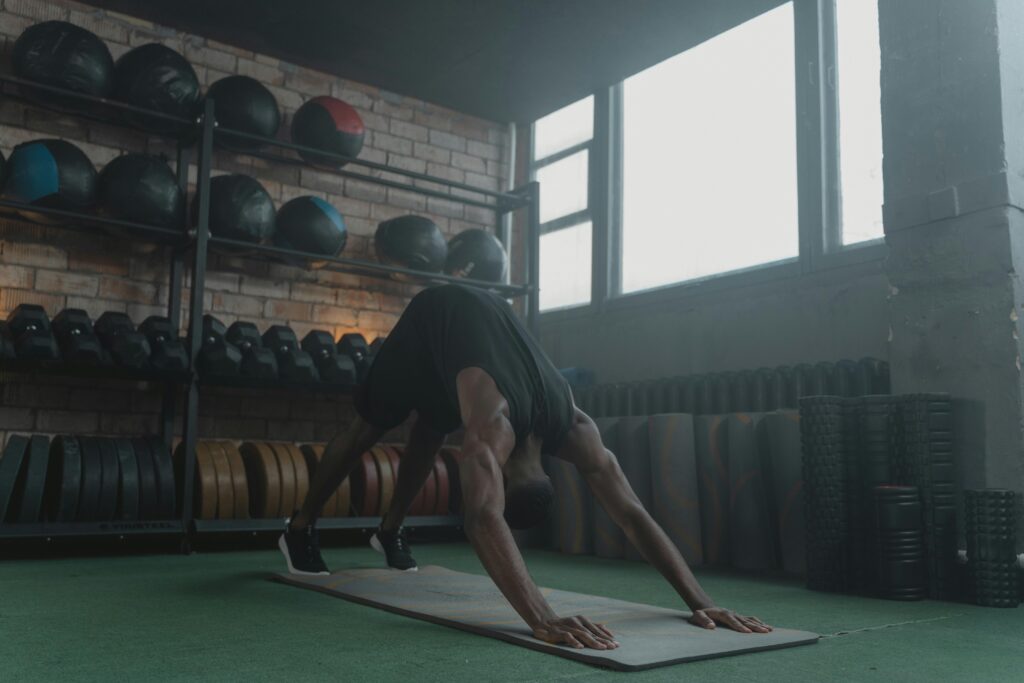Starting a workout routine sounds simple, but sticking to it can be challenging. That’s where most people stumble. If you’ve ever started strong only to lose steam after a week or two, you’re not alone. I’ve been there, too, but I found that with the right mindset and structure, I was able to build a lasting, energizing fitness habit. In this guide, I’ll share my journey and walk you through exactly how to start a workout routine and keep it going.
In This Article
Why Starting a Workout Routine is Important
Before we discuss how to start a workout routine, it’s essential to understand why exercise is crucial for your health. Regular physical activity reduces chronic disease risk, enhances mental health, and improves overall well-being. Whether your goal is weight loss, muscle gain, or improved overall fitness, developing a consistent workout habit can significantly impact your life.
How to Start a Workout Routine
If you’re wondering how to start a workout routine, you’re not alone. Many people struggle with getting into the habit of regular exercise, but the good news is that starting a fitness routine is simpler than you might think. With the right mindset, clear goals, and a well-structured plan, you can begin a workout regimen that helps you achieve your fitness objectives. In this guide, we’ll break down the steps to kickstart your fitness journey, from setting goals to staying motivated, making the process feel manageable and reassuring.
1. Set Clear and Achievable Fitness Goals

When learning how to start a workout routine, the first step is to define your goals. Why do you want to start exercising? Build muscle, lose weight, increase flexibility, or improve your heart health? Your goals will shape your workout routine and keep you motivated. Set clear and achievable fitness goals. This will help you feel empowered and in control of your fitness journey.
SMART Goals
Use the SMART goal framework to set Specific, Measurable, Achievable, Relevant, and Time-bound goals. For example, a SMART goal would be, “I want to run 3 miles without stopping in 2 months.” instead of saying, “I want to get fit.”
2. Choose the Right Type of Exercise for Your Goals

Choosing your exercises will depend on your fitness goals. Here’s a breakdown of workout types based on shared objectives:
Weight Loss:
Achieving effective weight loss requires a balanced approach that includes cardiovascular exercises and strength training. Cardiovascular exercises like running, cycling, swimming, and brisk walking elevate heart rate and burn calories. You can try 150 minutes of moderate-intensity or 75 minutes of high-intensity cardio each week. This can be broken down into manageable weekly sessions, such as 30 minutes a day, five days a week.
In addition to cardiovascular activities, strength training is crucial for weight loss as it builds lean muscle mass, which increases metabolism. Incorporate strength training twice to three weekly to target all major muscle groups. You can exercise free weights, use resistance bands, or your body weight. Good options include push-ups, squats, and lunges. Combining these types of exercise enhances calorie burn during workouts, promotes recovery, and increases overall body strength and endurance. Additionally, don’t ignore the implication of a balanced diet and staying hydrated, as they are vital to your weight loss journey.
You can read our tips on the best exercises for weight loss in this article.
Muscle Building:
To build muscle, consider incorporating resistance training, such as weightlifting or bodyweight exercises, into your fitness routine. This approach allows you to specifically target different muscle groups, which can improve strength, endurance, and overall muscle definition. For instance, free weights like dumbbells or barbells can help focus on major muscle groups such as the chest, back, and legs. At the same time, bodyweight exercises like push-ups, squats, and lunges engage multiple muscles simultaneously. To build muscle and strength evenly throughout your body, incorporate a variety of exercises into your workout routine. Changing your routine periodically helps keep your muscles challenged and prevents you from hitting a plateau in your progress.
Flexibility:
Engaging in Yoga or Pilates can significantly enhance your flexibility while improving muscle tone. Yoga incorporates a variety of postures and stretches that promote muscle relaxation and increase joint mobility. This helps improve your posture and prevents injuries. On the other hand, Pilates focuses on core strength and stability, utilizing controlled movements to target specific muscle groups. This practice is particularly effective for toning muscles without adding bulk, as it emphasizes precision and alignment. Together, Yoga and Pilates provide a holistic approach to conditioning the body, making them excellent choices for those looking to enhance flexibility and achieve a more defined physique.
Endurance:
Swimming, running, or cycling can significantly enhance your stamina and overall endurance. These forms of exercise require sustained physical effort, which helps to strengthen the cardiovascular system, improve lung capacity, and increase muscular resilience. Participating in these activities helps to build a solid aerobic base and accomplish physical tasks for a more extended duration without experiencing fatigue. Suppose you prefer the rhythmic strokes of swimming, the invigorating pace of running, or the smooth cadence of cycling. In that case, each of these endurance sports contributes uniquely to boosting your stamina and overall physical fitness.
Mix It Up
A good workout routine should include strength training, cardio, and flexibility exercises. This approach helps you stay fit and healthy, prevent injury, and keep your workouts interesting.
Here’s our complete guide to Full Body Workouts.
3. Start Small and Build Gradually

One of the most common mistakes people make when starting a workout routine is doing too much too soon. This often leads to burnout or injury. It’s crucial to pace yourself when figuring out how to start a workout routine.
Beginner’s Workout Plan
- Week 1-2: Start with 2-3 days of weekly light exercise. You can try walking, light jogging, or beginner-level workouts.
- Week 3-4: Gradually increase the intensity and add more workouts, like bodyweight strength exercises (push-ups, squats).
- After Week 4: Aim for at least 3-4 workout sessions per week, adding more variety and intensity over time.
For more tips on creating a balanced routine, you might find this article from the American Heart Association useful.
4. Stay Consistent with a Schedule

The key to success when starting a workout routine is consistency. One of the best ways to stay consistent is to design and stick to a workout schedule. Treat your workouts like an appointment that you can’t miss.
How to Build a Workout Schedule
· Morning Person? Schedule your workouts early in the day to avoid interruptions.
· Evening Person? If you’re more energetic after work, plan your routine for the evenings.
· Busy Week? Don’t skip workouts; instead, do shorter, high-intensity workouts (like HIIT) when you’re short on time.
I’ve always been an evening person because during the day, I had my job, and I was only free in the evenings. Sometimes, you indeed feel tired after a long day’s work, but I’ve developed a strong routine and discipline of training in the evening. Over time, it’s become easy, to the point where I feel an emptiness if I don’t train.
5. Track Your Progress

Tracking your progress helps you stay motivated. You can use a fitness app to record your workouts or a simple notebook, including the type of exercise, duration, and how you felt afterward. Watching your progress helps you feel accomplished and shows you where you can improve.
I started by using a simple Google Sheet to keep track of my workouts. Later, I realized I could monitor my progress without any tools. This change took some time, but I was able to manage it.
Types of Progress to Track
- Physical Progress: Weight loss, muscle definition, stamina.
- Performance Progress: Lifting heavier weights, running longer distances, completing more reps.
6. Incorporate Rest and Recovery

Taking rest days is just as crucial as exercising. Rest helps your body feel better and get stronger, which is essential for reaching your fitness goals. Overtraining can conduct to injury and burnout, so allowing your body to recover is necessary for your well-being.
How Much Rest Do You Need?
For beginners, it’s best to have one or two rest days per week. Active recovery activities like walking or light stretching can enhance blood circulation and assist in muscle repair.
7. Stay Motivated

Maintaining motivation over time can be difficult, particularly when immediate results are expected. But motivation is vital to sticking with your workout routine.
Tips for Staying Motivated :
- Set Short-Term Milestones: Achieve smaller goals along the way, like completing ten push-ups or running a mile without stopping.
- Find a Workout Buddy: Exercising with a friend can make your routine more fun and keep you accountable.
- Reward Yourself: When you hit a goal, reward yourself with something non-food related, like new workout gear.
For additional motivation tips, check out this article on workout motivation.
Sample Beginner Weekly Workout Plan
As a beginner, keep things simple! Start with a basic plan that fits your schedule and lifestyle. You can try this practical plan or create your own based on your needs and availability.
| Day | Activity | Focus |
|---|---|---|
| Monday | 30-min brisk walk | Cardio |
| Tuesday | Rest | Recovery |
| Wednesday | 3 rounds: squats, pushups, lunges, planks | Strength |
| Thursday | Light yoga/stretching | Flexibility |
| Friday | 20-min dance workout | Cardio/Fun |
| Saturday | Resistance bands or light dumbbell workout | Strength |
| Sunday | Optional: Walk or full rest | Recovery |
FAQs
A good beginner workout schedule includes 2 to 3 days of cardio, 2 days of strength workouts, and at least 1 day for flexibility or stretching. Start slowly and increase your activity as your body adjusts.
Start with easy and fun exercises. Set specific goals and create a weekly plan to achieve them. Stick to it consistently. For the best results, mix aerobic exercises with strength training.
The 3-3-3 rule typically refers to performing 3 sets of 3 exercises, done 3 times per week. It’s a minimalist strength approach designed for simplicity and consistency.
This method involves 5 minutes of cardio, 4 minutes of strength training, 3 minutes of core exercises, 2 minutes of flexibility training, and 1 minute of deep breathing. It’s efficient and beginner-friendly.
Take Action and Start Your Fitness Journey
Now that you know how to start a workout routine, the next step is to take action. Remember, it’s not about being perfect, it’s about making consistent progress. Start small, stay motivated, and watch your fitness improve over time. If you’re ready to begin your journey, create a plan, set realistic goals, and get moving today!
Want more workout tips? Subscribe to our newsletter and get daily fitness advice straight to your inbox!

